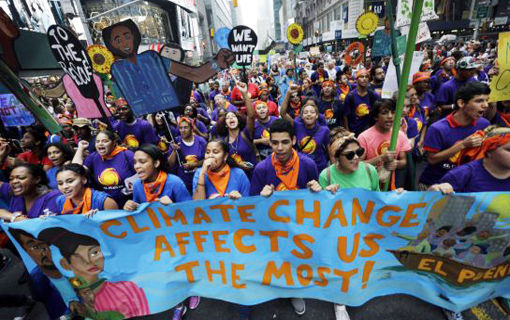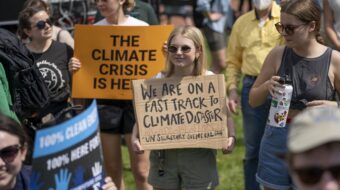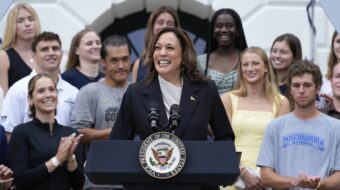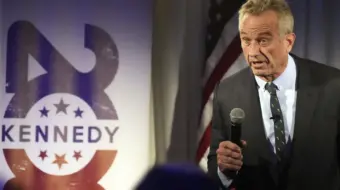
As a follow-up to the huge march to fight climate change last September, 250 activists streamed into the Manhattan headquarters of AFSCME DC 37 for a forum on proposed climate and environmental legislation for New York City. The Mar. 16 conference was called by 350.org, the organization which initiated the call for the march last September. It has been calling for global steps to reduce carbon emissions to bring the earth’s atmospheric carbon dioxide levels below 350 parts per million.
The earth’s atmosphere had 275 parts per million of carbon dioxide, until civilization started to burn fossil fuels, such as coal, gas, and oil, at a steadily increasing rate. Carbon dioxide in the atmosphere is now about 400 parts per million (400 ppm), and increasing about 2 ppm annually. So far, this increase has caused a rise in the temperature about one degree Celsius, or 1.8 degrees Fahrenheit. At the present rate of carbon emissions into the atmosphere, there will be melting glaciers, rising oceans, more moisture in the atmosphere, resulting in larger storms, flooding in coastal areas, droughts in other areas, extinction of many forms of life, swarms of mosquitoes, which thrive in warmer weather, and many other devastating changes.
The new proposed legislation for New York City to help fight climate change and environmental degradation has the support of Mayor Bill de Blasio, and many New York City Council members. It will still take a struggle to get this legislation passed and enforced over the objections of the energy industry, ultra-right political forces, real estate developers, and other elements who deny that climate change has been caused by humankind’s burning of fossil fuels to heat our homes, light our streets, drive our automobiles, fly our airplanes, and run our industries.
Covering issues of wasting energy, reducing carbon emissions, and other environmental issues, the proposed legislation is very broad. It includes setting a goal of reduction of carbon emissions by 80 percent by 2050, updating New York City’s air code, heating all buildings owned by the city with solar panels, using biofuels on ferries and other boats owned by the city, reducing methane emissions (which heat the atmosphere much more than carbon dioxide), a requirement that lights be turned off in buildings or rooms when the space is not being used, fines for trucks idling their motors while parked, phasing out excessively polluting school buses, and numerous other issues.
A description of the legislation was given by Donovan Richards, a City Council member elected in 2013 from a district which includes parts of Laurelton, Springfield Gardens, Rochdale, the Rockaways, Jamaica Bay, and other areas close to the ocean on the south side of Queens, much of which was severely flooded and damaged by the Superstorm Sandy in 2013. He chairs the New York City Council on Environmental Protection, which is trying to shepherd the legislation through City Council.
Judy Sheridan-Gonzalez, president of the New York State Nurses Association, gave a militant speech, warning that the ultra-right will try to water down the legislation, handcuff its enforcement, and weaken any regulations issued by the city pursuant to the proposed legislation. She warned that the energy industries already spend $3.5 billion per year in lobbying to defeat any such legislation and funding front groups which deny climate change science. She explained that these same huge corporations, like the real estate developers of New York, do not care about the advancing dangers of climate change and other environmental hazards. She called for energy justice and energy democracy, so that working people and the poor, many of whom live in endangered coastal areas, do not bear the brunt of climate change and other pollution.
As a nurse, Sheridan-Gonzalez said, she has seen first-hand the effects of increased air pollution, which causes increased asthma in her patients. She pointed out that the labor movement as a whole in New York was willing to fight climate change, but some unions, such as electrical workers and the construction trades, were fearful of job losses if polluting power plants and other industries were closed or diminished. She said that the creation of green jobs, such as installing solar panels or insulating inefficient buildings, could help alleviate job losses.
The ambassador to the United Nations from the nation of Vanuatu, a chain of islands in the South Pacific, gave a heartfelt plea for assistance to help the country recover from the catastrophic devastation of a mammoth typhoon, with winds up to 185 mph, which struck early on Saturday morning, Mar. 14.
Eddie Bautista, executive director of the New York City Environmental Justice Alliance, spoke, saying that the fight against climate change and pollutants in the atmosphere is a fight for social, economic, and racial justice, because working people, the poor, and oppressed minorities are affected much more by climate change and environmental damage. Bautista also pointed out that industrial activity on shorelines often exacerbates the effects of storm surges, particularly during Superstorm Sandy.
Ray Figueroa, president of the New York City Community Gardens Coalition, alerted climate activists that real estate developers, with the apparent acquiescence of the New York City Department of Housing Preservation and Development, were planning to bulldoze and destroy 17 beloved community gardens in order to build luxury and some affordable housing. He pointed out that these gardens are not only beautiful, peaceful places for nearby residents, but also retard flooding and absorb carbon dioxide out of the atmosphere.
After the speakers, conference participants broke down into several groups for more in-depth and specialized discussions, such as making community organizations more alert to the dangers of climate change; explaining how community groups joined together to recover from the effects of Sandy; examining in detail the new proposed legislation; how to get the legislation enacted into law without being weakened by big business; enforcing the legislation once it is enacted; and planning strategies for further actions to fight climate change.
The participants returned after the smaller group discussion for a plenary session. Moderator Leslie Cagan, one of the lead organizers of September’s Climate Change March, pointed out that 350.org and the People’s Climate Movement were not just gearing up for the new legislation, but were really trying to build a strong city-wide movement to fight climate change.
Another conference is planned for Mar. 31, at the UAW offices in Manhattan. It is important that the labor movement plays a big role in the fight against climate change. Its muscle and leadership are critical in building a wide and diverse movement.
Photo: Mel Evans/AP












Comments